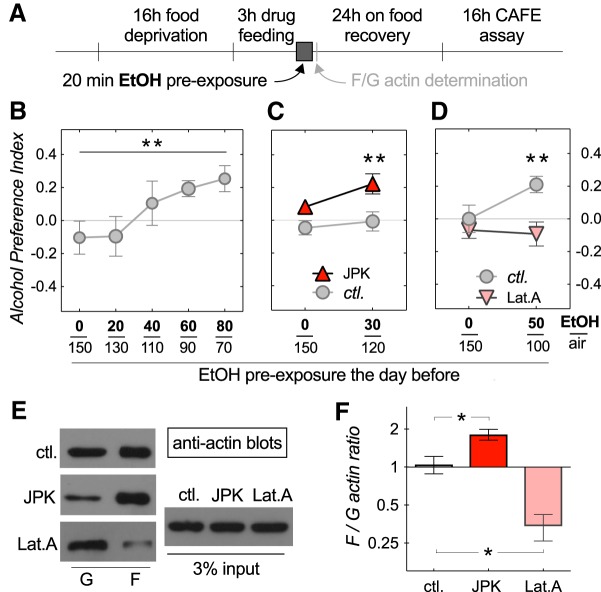Figure 1.
Effects of altered actin polymerization on EDAP. A, Schematic of the experimental design. Flies were food deprived for 16 h before a 3 h feeding on control food or food with either 200 nm JPK to increase, or with 8.0 μg/ml Lat.A to decrease the F/G-actin ratio. Following the drug feeding, flies were pre-exposed to an ethanol vapor (EtOH) and air mixture for 20 min, and then allowed to recover for 24 h on standard fly food. Flies were then assayed in a 16 h abbreviated CAFÉ assay. B, Control flies (w* Berlin) show a dose-dependent switch from alcohol avoidance to alcohol preference (slope of linear regression 0.005 ± 0.003 95% CI, significantly different from 0, **p = 0.0028, n = 6 per dose). Ethanol vapor to air ratios for the pre-exposures are displayed on the x-axis. C, Pre-feeding on JPK caused EDAP at a subthreshold pre-exposure dose (two-way ANOVA, with a significant effect: F(1,44) = 11.9, p = 0.0012 of JPK; Sidak's multiple post hoc comparison, **p = 0.006 at 30/120 EtOH/air, n = 12 per data point). D, Pre-feeding on Lat.A prevented EDAP at a dose which induced preference in control flies (two-way ANOVA, with a significant effect: F(1,44) = 7.9, p = 0.0074 of Lat.A; Sidak's multiple post hoc comparison, **p = 0.0046 at 50/100 EtOH/air, n = 12). E, Anti-actin Western blots run from whole fly extracts. Blots on left show globular (G) and filamentous (F) actin fractions. The input extract shown on the right. F, Western blot quantification shows significant, predicted changes in F/G-actin ratios (one-way ANOVA, F(2,6) = 24.5, p = 0.0013, with Dunnett's post hoc multiple comparisons, *p < 0.027, n = 3; shown in this, and following figures, except Fig. 5, are mean with SE).

